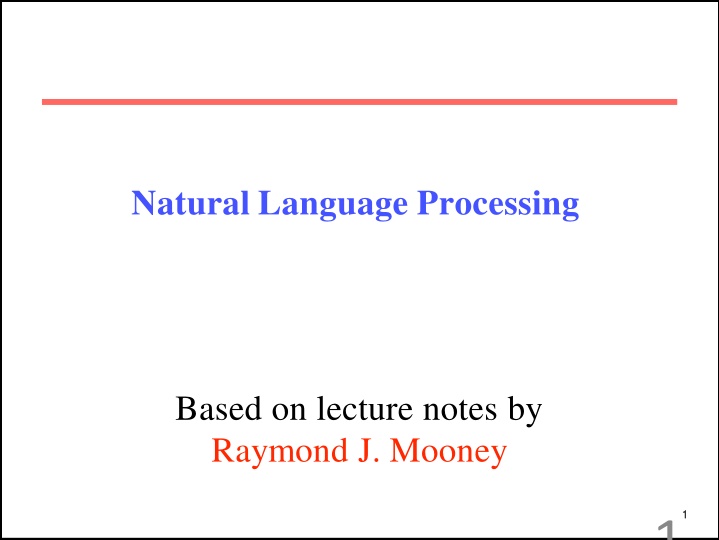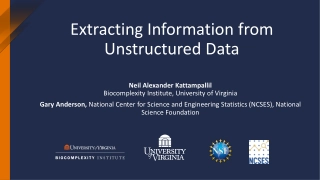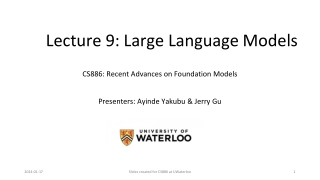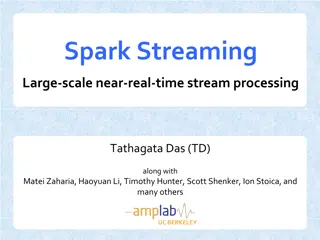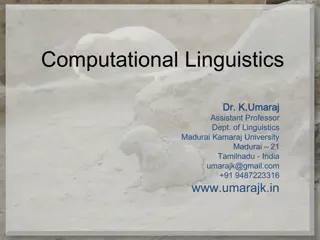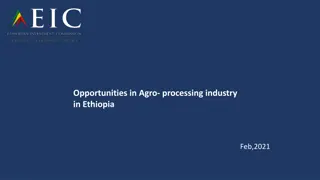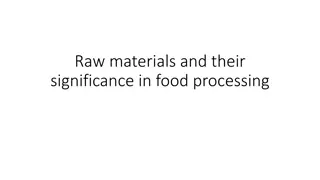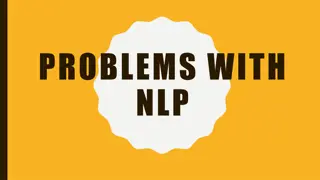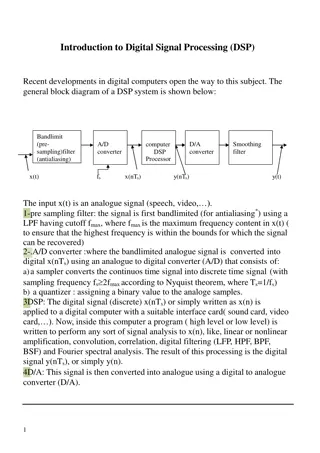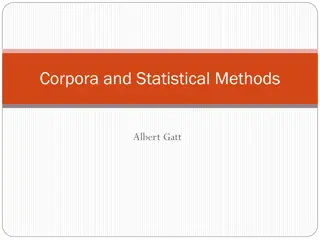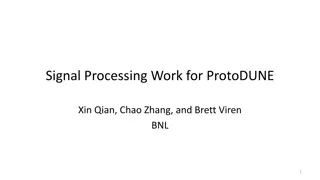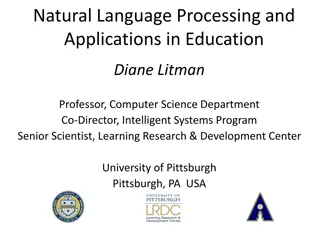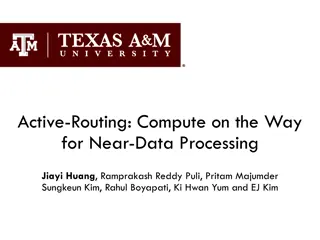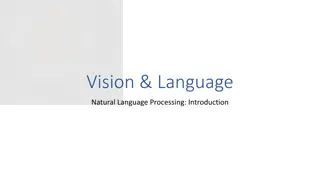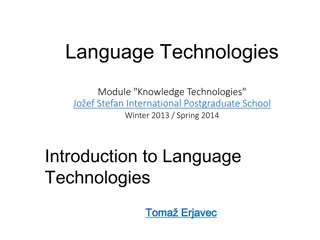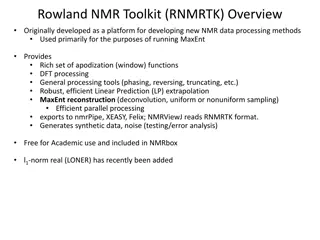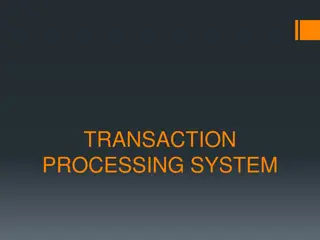Natural Language Processing
Natural Language Processing (NLP) is a vital branch of computer science that focuses on enabling computers to communicate effectively with humans using everyday language. This involves various processes such as communication, syntax, semantics, pragmatics, and handling ambiguity. NLP systems aim to facilitate seamless interaction between humans and machines, enhancing user experience and enabling efficient information processing. This in-depth exploration delves into the intricacies of NLP, shedding light on its core concepts and applications.
Download Presentation

Please find below an Image/Link to download the presentation.
The content on the website is provided AS IS for your information and personal use only. It may not be sold, licensed, or shared on other websites without obtaining consent from the author.If you encounter any issues during the download, it is possible that the publisher has removed the file from their server.
You are allowed to download the files provided on this website for personal or commercial use, subject to the condition that they are used lawfully. All files are the property of their respective owners.
The content on the website is provided AS IS for your information and personal use only. It may not be sold, licensed, or shared on other websites without obtaining consent from the author.
E N D
Presentation Transcript
Natural Language Processing Based on lecture notes by Raymond J. Mooney 1 1
Natural Language Processing NLP is the branch of computer science focused on developing systems that allow computers to communicate with people using everyday language. Also called Computational Linguistics Also concernshow computational methods can aid the understanding of human language 22
Communication The goal in the production and comprehension of naturallanguage is communication. Communicationfor the speaker: Intention: Decide when and what information should be transmitted (a.k.a. strategic generation). May require planning and reasoning about agents goals and beliefs. Generation: Translate the information to be communicated (in internal logical representation or language of thought ) into string of words in desired natural language (a.k.a. tactical generation). Synthesis: Output the string in desired modality, text or speech. 3 3
Communication (cont) Communicationfor the hearer: Perception: Map input modality to a string of words, e.g. optical character recognition (OCR) or speech recognition. Analysis: Determine the information content of the string. Syntactic interpretation (parsing): Find the correct parse tree showing the phrase structureof the string. Semantic Interpretation: Extract the (literal) meaning of the string (logical form). Pragmatic Interpretation: Consider effect of the overall context on altering the literal meaning of a sentence. Incorporation: Decide whether or not to believe the content of the string and add it to the KB. 4 4
Syntax, Semantic, Pragmatics Syntax concerns the proper ordering of words and its affect on meaning. Thedog bit the boy. Theboy bit the dog. * Bit boy dog the the. Colorless green ideas sleep furiously. Semantics concerns the (literal) meaning of words, phrases, and sentences. plant as a photosynthetic organism plant as a manufacturing facility plant as the act of sowing Pragmatics concerns the overall communicative and social context and its effect on interpretation. The ham sandwich wants another beer. (co-reference, anaphora) John thinks vanilla. (ellipsis) 6 5
ModularComprehension Acoustic/ Phonetic Pragmatics Syntax Semantics words literal parse sound waves meaning (contextualized) trees meaning 7 6
Ambiguity Natural language is highly ambiguous and must be disambiguated. I saw the man on the hill with a telescope. I saw the Grand Canyon flying to LA. Time flies like an arrow. Horse flies like a sugar cube. Time runners like a coach. Time cars like a Porsche. 8 7
Ambiguity is Ubiquitous Speech Recognition recognize speech vs. wreck a nice beach youth in Asia vs. euthanasia Syntactic Analysis I ate spaghettiwith chopsticks vs. I ate spaghetti with meatballs. Semantic Analysis The dog is in the pen. vs. The ink is in the pen. I put the plant in the window vs. Ford put the plant in Mexico Pragmatic Analysis From The Pink Panther Strikes Again : Clouseau:Doesyour dog bite? HotelClerk: No. Clouseau: [bowing down to pet the dog] Nice doggie. [Dog barks and bites Clouseau in the hand] Clouseau: I thought you said your dog did not bite! Hotel Clerk: That is not my dog. 9 8
Ambiguityis Explosive Ambiguities compound to generate enormous numbers of possible interpretations. In English, a sentence ending in n prepositional phrases has over 2nsyntactic interpretations (cf. Catalan numbers). I saw the man with the telescope : 2 parses I saw the man on the hill with the telescope. : 5 parses I saw the man on the hill in Texas with the telescope : 14 parses I saw the man on the hill in Texas with the telescope at noon. : 42 parses I saw the man on the hill in Texas with the telescope at noon on Monday 132 parses 10 9
Humor and Ambiguity Many jokes rely on the ambiguity of language: Groucho Marx: One morning I shot an elephant in my pajamas. How he got into my pajamas, I ll never know. She criticized my apartment, so I knocked her flat. Noah took all of the animals on the ark in pairs. Except the worms, they came in apples. Policeman to little boy: We are looking for a thief with a bicycle. Little boy: Wouldn t you be better using your eyes. Why is the teacher wearing sun-glasses. Because the class is so bright. 11 10
Natural Languages vs. Computer Languages Ambiguity is the primary difference between naturaland computer languages. Formal programming languages are designed to be unambiguous, i.e. they can be defined by a grammar that produces a unique parse for each sentence in the language. Programming languages are also designed for efficient (deterministic) parsing, i.e.they are deterministiccontext-free languages (DCLFs). A sentence in a DCFL can be parsed in O(n) time where n is the length of the string. 12 11
Syntactic Parsing Produce the correct syntactic parse tree for a sentence. 12
Context Free Grammars (CFG) N a set of non-terminal symbols (or variables) a set of terminal symbols (disjoint from N) R a set of productions or rules of the form A , where A is a non-terminal and is a string of symbols from ( N)* S, a designated non-terminal called the start symbol 13
Simple CFG for ATIS English Grammar Lexicon S NP VP S Aux NP VP S VP NP Pronoun NP Proper-Noun NP Det Nominal Nominal Noun Nominal Nominal Noun Nominal Nominal PP VP Verb VP Verb NP VP VP PP PP Prep NP Det the | a | that | this Noun book| flight | meal | money Verb book | include | prefer Pronoun I | he | she | me Proper-Noun Houston | NWA Aux does Prep from | to | on | near | through 14
SentenceGeneration Sentences are generated by recursively rewriting the start symbol using the productions until only terminalssymbols remain. S Derivation or Parse Tree VP Verb NP book Det Nominal the Nominal PP Noun Prep NP flight through Proper-Noun Houston 15
Parse Trees and Syntactic Ambiguity If a sentence has more than one possible derivation (parse tree) it is said to be syntactically ambiguous. 17 16
Prepositional Phrase Attachment Explosion A transitive English sentence ending in m prepositional phrases has at least 2mparses. I saw the man on the hill with a telescope on Tuesdayin Austin . The exact number of parses is given by the Catalan numbers (where n=m+1) 1, 2, 5, 14, 132, 429, 1430, 4862, 16796, 18 17
SpuriousAmbiguity Most parse trees of most NL sentences make no sense. 19 18
Parsing Given a string of non-terminals and a CFG, determineif the string can be generated by the CFG. Also return a parse tree for the string Also return all possible parse trees for the string Must search spaceof derivations for one that derives the given string. Top-Down Parsing: Start searching space of derivations for the start symbol. Bottom-up Parsing: Start search space of reverse deivations from the terminal symbols in the string. 19
ParsingExample S VP Verb NP bookthatflight book Det Nominal that Noun flight 20
Treebanks EnglishPenn Treebank: Standard corpus for testing syntactic parsing consists of 1.2 M words of text from the Wall Street Journal (WSJ). Typical to train on about 40,000 parsed sentences and test on an additional standard disjoint test set of 2,416sentences. Chinese Penn Treebank: 100K words from the Xinhua news service. Other corpora existing in many languages, see the Wikipediaarticle Treebank 85 21
First WSJ Sentence ( (S (NP-SBJ (NP (NNP Pierre) (NNP Vinken) ) (, ,) (ADJP (NP (CD 61) (NNS years) ) (JJ old) ) (, ,) ) (VP (MD will) (VP (VB join) (NP (DT the) (NN board) ) (PP-CLR (IN as) (NP (DT a) (JJ nonexecutive) (NN director) )) (NP-TMP (NNP Nov.) (CD 29) ))) (..))) 86 22
Parsing Evaluation Metrics PARSEVAL metrics measure the fraction of the constituents that match between the computed and human parse trees. If P is the system s parse tree and T is the human parse tree (the gold standard ): Recall = (# correct constituents in P) / (# constituents in T) Precision = (# correct constituents in P) / (# constituents in P) Labeled Precision and labeled recallrequire getting the non-terminal label on the constituent node correct to count as correct. F1is the harmonic mean of precision and recall. 87 23
Computing Evaluation Metrics CorrectTreeT S Computed Tree P S VP VP Verb book Det Nominal the Nominal Noun Prep NP VP Verb book NP PP NominalPP Det NP Noun Prep flight through Proper-Noun NP the flight through Proper-Noun Houston Houston # Constituents: 12 #Constituents:12 # CorrectConstituents: 10 Recall = 10/12= 83.3% Precision = 10/12=83.3% F1=83.3%24
Treebank Results Results of current state-of-the-art systems on the English Penn WSJ treebank are slightly greater than 90% labeled precision and recall. 89 25
Word Sense Disambiguation (WSD) Words in natural language usually have a fair number of different possible meanings. Ellen has a strong interest in computational linguistics. Ellen pays a large amount of interest on her credit card. For many tasks (question answering, translation), the proper sense of each ambiguous word in a sentence must be determined. 90 26
Ambiguity Resolution is Required for Translation Syntactic and semantic ambiguities must be properly resolved for correct translation: John plays the guitar. John toca la guitarra. John plays soccer. John juega el f tbol. An apocryphal story is that an early MT system gave the following resultswhen translatingfrom English to Russianand then back to English: The spirit is willing but the flesh is weak. The liquor is good but the meat is spoiled. Out of sight, out of mind. Invisible idiot. 91 27
Word Sense Disambiguation (WSD) as Text Categorization Each sense of an ambiguous word is treated as a category. play (verb) play-game play-instrument play-role pen (noun) writing-instrument enclosure Treat current sentence (or preceding and current sentence) as a document to be classified. play : play-game: John played soccer in the stadium on Friday. play-instrument: John played guitar in the band on Friday. play-role: John played Hamlet in the theater on Friday. pen : writing-instrument: John wrote the letter with a pen in New York. enclosure: John put the dog in the pen in New York. 92 28
Learning for WSD Assume part-of-speech (POS), e.g. noun, verb, adjective, for the target word is determined. Treat as a classification problem with the appropriate potential senses for the target word given its POS as the categories. Encode context using a set of features to be used for disambiguation. Train a classifier on labeled data encoded using thesefeatures. Use the trained classifier to disambiguate future instances of the target word given their contextual features. 93 29
WSD line Corpus 4,149 examples from newspaper articles containing the word line. Each instance of line labeled with one of 6 senses from WordNet. Each example includes a sentence containing line and the previous sentence for context. 94 30
Senses of line Product: While he wouldn t estimate the sale price, analysts have estimated that it would exceed $1 billion. Kraft also told analysts it plans to develop and test a line of refrigerated entrees and desserts, under the Chillery brand name. Formation: C-LD-R L-V-S V-NNA reads a sign in Caldor s book department. The 1,000 or so people fighting for a place in line have no trouble filling in the blanks. Text: Newspaper editor Francis P. Church became famous for a 1897 editorial, addressed to a child, that included the line Yes, Virginia, there is a SantaClause. Cord: It is known as an aggressive, tenacious litigator. Richard D. Parsons, a partner at Patterson,Belknap, Webb and Tyler, likes the experience of opposing Sullivan & Cromwell to having a thousand-pound tuna on the line. Division: Today, it is more vital than ever. In 1983, the act was entrenched in a new constitution, which established a tricameral parliament along racial lines, whith separatechambers for whites, coloreds and Asians but none for blacks. Phone: On the tape recording of Mrs. Guba's call to the 911 emergency line, played at the trial, the baby sitter is heard begging for an ambulance. 95 31
Experimental Data for WSD of line Sample equal number of examples of each sense to construct a corpus of 2,094. Represent as simple binary vectors of word occurrences in 2 sentence context. Stop words eliminated Stemmed to eliminate morphological variation Final examples represented with 2,859 binary word features. 96 32
Learning Algorithms Na ve Bayes Binary features K Nearest Neighbor Simple instance-based algorithm with k=3 and Hamming distance Perceptron Simple neural-network algorithm. C4.5 Stateof the art decision-tree induction algorithm PFOIL-DNF Simple logical rule learner for Disjunctive NormalForm PFOIL-CNF Simple logical rule learner for Conjunctive Normal Form PFOIL-DLIST Simple logical rule learner for decision-list of conjunctive rules 97 33
Discussion of Learning Curves for WSD of line Na ve Bayes and Perceptron give the best results. Both use a weighted linear combination of evidence from many features. Symbolic systems that try to find a small set of relevant features tend to overfit the trainingdata and are not as accurate. Nearest neighbor method that weights all features equallyis also not as accurate. Of symbolic systems, decision lists work the best. 99 34
Word Segmentation Breaking a string of characters (graphemes) into a sequence of words. In some written languages (e.g. Chinese) words are not separated by spaces. Even in English, characters other than white-space can be used to separatewords [e.g. , ; . - : ( ) ] Examplesfrom EnglishURLs: jumptheshark.com jump the shark .com myspace.com/pluckerswingbar myspace .com pluckers wing bar myspace .com plucker swing bar 36
MorphologicalAnalysis Morphology is the field of linguistics that studies the internal structure of words. (Wikipedia) A morpheme is the smallest linguistic unit that has semantic meaning (Wikipedia) e.g. carry , pre , ed , ly , s Morphological analysis is the task of segmenting a word into its morphemes: carried carry + ed (past tense) independently in + (depend + ent) + ly Googlers (Google + er) + s (plural) unlockable un + (lock + able) ? (un + lock) + able ? 37
Part Of Speech (POS) Tagging Annotate each word in a sentence with a part-of-speech. I ate the spaghetti with meatballs. Pro V Det N Prep N John saw the saw and decided to take it to the table. PN V Det N Con V Part V Pro Prep Det N Useful for subsequent syntactic parsing and word sense disambiguation. 38
PhraseChunking Find all non-recursive noun phrases (NPs) and verb phrases (VPs) in a sentence. [NP I] [VP ate] [NP the spaghetti] [PP with] [NP meatballs]. [NP He ] [VP reckons ] [NP the current account deficit] [VP will narrow ] [PPto ] [NP only # 1.8 billion] [PP in ] [NP September ] 39
Semantic Role Labeling (SRL) For each clause, determine the semantic role played by each noun phrase that is an argument to the verb. agent patient source destination instrument John drove Mary from Austin to Dallas in his Toyota Prius. The hammer brokethe window. Also referred to a case role analysis, thematic analysis, and shallow semantic parsing 106 41
SemanticParsing A semantic parser maps a natural-language sentence to a complete, detailed semantic representation(logical form). For many applications, the desired output is immediatelyexecutableby another program. Example: Mapping an English database query to Prolog: How many cities are there in the US? answer(A, count(B, (city(B), loc(B, C), const(C, countryid(USA))), A)) 107 42
TextualEntailment Determine whether one natural language sentence entails (implies) another under an ordinary interpretation. 43
Textual Entailment Problems from PASCAL Challenge ENTAIL MENT HYPOTHESIS TEXT Eyeingthe huge market potential, currently led by Google, Yahoo took over search companyOverture Services Inc lastyear. Microsoft's rival Sun Microsystems Inc. bought Star Office last month and plans to boost its development as a Web-based device running over the Net on personal computersandInternet appliances. The NationalInstituteforPsychobiologyin Israelwas establishedin May 1971 as the IsraelCenterforPsychobiologyby Prof. Joel. Since its formation in 1948, Israel fought many wars with neighboring Arab countries. TRUE Yahoo bought Overture. FALSE Microsoft boughtStarOffice. Israel was establishedin May FALSE 1971. Israelwasestablishedin 1948. TRUE 44
AnaphoraResolution/ Co-Reference Determine which phrases in a document refer to the same underlying entity. John put the carrot on the plate and ate it. Bush started the war in Iraq. But the president needed the consent of Congress. Some cases require difficult reasoning. Todaywas Jack's birthday. Penny and Janet went to the store. They were going to get presents. Janet decided to get a kite. "Don't do that," said Penny. "Jack has a kite. He will make you takeit back." 46
OtherTasks 47
Information Extraction (IE) Identify phrases in language that refer to specific types of entities and relations in text. Named entity recognition is task of identifying names of people, places, organizations, etc. in text. people organizations Michael Dell is the CEO of Dell Computer Corporation and lives in Austin Texas. Relation extractionidentifiesspecific relations betweenentities. Michael Dell is the CEO of Dell Computer Corporation and lives in Austin Texas. places 114 48
QuestionAnswering Directly answer natural language questions based on information presented in a corpora of textual documents (e.g. the web). When was BarackObama born? (factoid) August 4, 1961 Who was president when Barack Obama was born? John F. Kennedy How many presidents have there been since BarackObama was born? 9 49
Text Summarization Produce a short summary of a longer document or article. Article: With a split decision in the final two primaries and a flurryof superdelegate endorsements, Sen. Barack Obama sealed the Democratic presidential nomination last night after a grueling and history-making campaign against Sen. Hillary Rodham Clinton that will make him the first African American to head a major-party ticket. Before a chanting and cheering audience in St. Paul, Minn., the first-term senator from Illinois savored what once seemed an unlikely outcome to the Democratic race with a nod to the marathon that was ending and to what will be another hard-fought battle, against Sen. John McCain, the presumptive Republican nominee . Summary: Senator Barack Obama was declared the presumptive Democratic presidential nominee. 50
